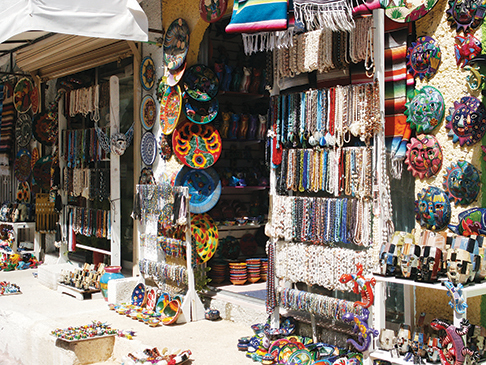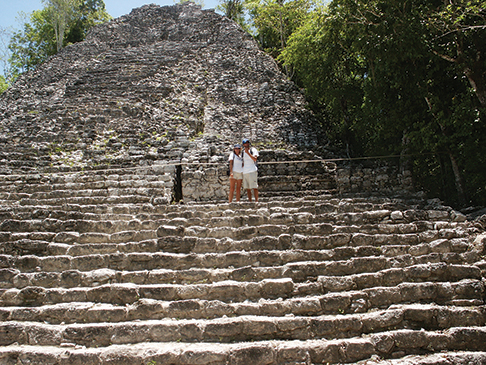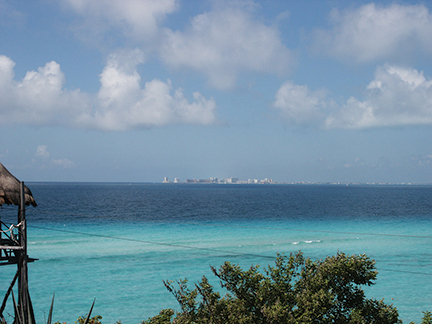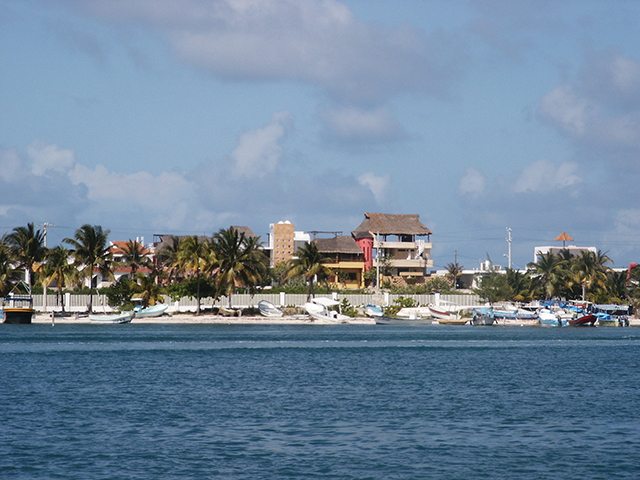Whiling away the weeks in a friendly, history-filled cruisers’ paradise (published February 2013)
As the sun rose across the island, we short tacked between Isla Mujeres and mainland Mexico. Among the ferries and pleasure boats, we saw several offshore sailboats that confirmed the chatter on the VHF radio: a few stragglers in the Regata del Sol al Sol from St. Petersburg were crossing the finish line. Having sailed north from Providencia, we too were looking forward to dropping our anchor in these vibrant turquoise waters, ending a several-day passage.

Isla Mujeres is a popular layover for sailors traveling between the States and the Western Caribbean, and with good reason. Located eight miles off Cancun on the tip of the Yucatan Peninsula, this tiny island (four miles long and a half mile wide) has managed to retain its small town charm in spite of its large draw of tourists.
CONTRABAND KITTIES
Though the clearing in process can be lengthy and costly, one advantage it offers is the opportunity to quickly become well acquainted with the town. We anchored in the bay on the western side of the island and rowed to shore, using the dinghy dock at the restaurant across the street from the port captain’s office. Because clearance requirements seem to change with each new port captain, it is best to check in with him before continuing your tour of town. If hunger overtakes you, the restaurant at the dinghy dock has excellent fish tacos for a reasonable price. Your next stop will likely be the small tienda a few blocks from the water that has a copy machine. (Head for the town square; it is on the corner by the large church.) Regardless of how many copies you have of your Zarpe from your previous port (even Americans coming from the States must have clearance papers), crew list, vessel documentation, and passports, it won’t be enough. Also near this square is a large supermarket with a well-stocked produce section. A smaller market is one block off the square, also on the corner, and has specialty items and an impressive deli.
While you are near the center of town, you will need to visit Sanitation at the health department. When we arrived the person to see was not available, and we were told to return later in the day. The next stop is Immigration, back on the waterfront street (Av. Rueda Medina) a few blocks north of the port captain’s office. The Immigration officers would not complete our paperwork until we had been certified by the Sanitation worker who happened to walk into Immigration as we were leaving to search the town for her. From Immigration we had to walk back south along the main road to pay our fee at the local bank and then return with a receipt. Copies of all the papers accumulated along the way were required by the port captain to complete day one of clearing in.
On day two several officials from Agriculture, Customs and the port captain’s office boarded and haphazardly searched our boat. Because our cats did not meet their unrealistic requirements of having received their rabies shots in the past 48 hours, day three involved rowing the cats to shore in a gale to meet the veterinarian at the port captain’s office. Because we would be staying in Mexico longer than 10 days, our fourth day of clearing in involved taking the ferry to Cancun and walking several blocks north of the ferry dock to the Immigration office. There we had to import the boat; in exchange for $50 and a short form, the boat was granted permission to stay (or come and go) in Mexican waters for the next 10 years.

PEDESTRIAN PARADISE
Once we were legally cleared in we wandered the dozen blocks of town on the north end of the island. The main street runs along the west coast, past the navy dock, port captain’s office, the ferry dock and several waterfront restaurants that cater to the tourists including hundreds of sport fishing captains and their clients and crew. A few blocks off the water we found smaller restaurants serving local fare to mostly locals. Because the food was so reasonably priced, we ate out more on Isla Mujeres than normal, occasionally even enjoying the street food, especially flautas from the vendor outside the supermarket.
Several blocks of town are for pedestrians only, consisting of bars and small shops of trinkets for visitors. Traditional Mayan dresses, ponchos, sombreros, cigars, silver jewelry and tequila are offered by bilingual hawkers polite enough to accept a negative response with a smile. The extreme northern tip of the island has several magnificent beaches. Though hotels abound in this area, the beaches are public and there is plenty of room for everyone. Along the Caribbean side of the island are several surfing spots if you are experienced in avoiding coral and rocks. To the east, the bay offers excellent snorkeling, but be aware that a lifejacket is required to snorkel of Isla Mujeres in order to protect the coral from curious, damaging fingers.
After surviving a five-day gale anchored in shallow sand on a hard bottom, we decided we deserved a marina and El Milagro fit our needs perfectly. Their rates are officially $1 a foot per day, but like most things in Mexico, that is negotiable. Once our son befriended the bilingual staff and started helping out around the property, we found that our dockage was reasonable enough to stay for two weeks. El Milagro became a comfortable home, with hot showers, Wi-Fi, a private beach, laundry onsite, a lending library, common kitchen, ping pong table, a restaurant and small tienda. For those who prefer to avoid the round-town trek, the marina has an agent who can, for a small fee, help clear you into Mexico without having to leave the property. They also offer complimentary kayak and bike rentals. We frequently borrowed the bikes to get groceries in town, a mile to the north, and when we decided to explore the entire island, bikes were the perfect transportation.
BEAUTIFUL RUINS

Headed south from the marina we came to a Y, the left fork headed toward the Caribbean, the right to the southern tip of the island. Past the Y we found Hacienda Mundaca. In the mid-1800s, Fermin Mundaca, a true pirate of the Caribbean, built this exquisite property and house for an indigenous girl he fell in love with, though she never returned the sentiment nor lived on the estate. The site is now a maintained historical site with gardens and walkways. Mundaca’s grave is in the cemetery on the north end of the island. Complete with skull and crossbones, his tomb reads “As you are, I once was; as I am, so shall you be.”
Continuing our bike ride to the southern point of the island, we found the ruins of a Mayan temple. Situated on a promontory, the temple was damaged in Hurricane Gilbert in 1988, but the restored site is now opened to visitors. For more impressive Mayan ruins, though, you must leave the island.
The ferry from Isla Mujeres took us to Cancun, where we hired a taxi to the bus terminal. A reasonable fare got us passage on an air-conditioned bus to Coba, the site of Mayan ruins dating back to the 500s. Not as large as Chichen Itza to the west, Coba has only recently been recaptured from the surrounding jungle. Fewer tourists visit Coba, and the ruins are closer to their original condition than the restored sites of other Mayan cities. Ancient roadways, called sacbe, built by the Mayas lead visitors among the ruins by foot or on rented bikes. Among the ruins are several temples, two ball courts, and countless stele, large stone slabs with writing and glyphs. The ancient pyramid at Coba is the tallest in the Yucatan Peninsula and visitors are still allowed to climb its 120 steps. From the top, 138 feet above the jungle, you can see other pyramids and lakes across the land that was once a large city. It is possible to visit Coba and still arrive back in Cancun in time to catch the last ferry back to Isla Mujeres the same day, if bus, taxi, and ferry schedules align properly.

Anchored out, in one of the many marinas on its west coast, or as a guest of one of the modern resort hotels, visitors to Isla Mujeres will find fun in all its forms: shopping, eating, drinking, swimming, exploring or just lying in the sand. We had planned to spend a few days in Isla Mujeres, but it took three weeks and the threat of an early tropical system to convince us that it was time to complete our trip back to the States. (For those who might stay too long, there is a decent hurricane hole in Laguna Makas, where pirates once hid.) Friendly people, excellent services, easy transportation and captivating sites to explore convinced us that this will not be our last visit to this enchanting Island of Women.
Connie McBride, her husband and their three sons sailed away on their 34-foot Creekmore in 2002. Since then they have explored much of the Caribbean. You can read about their adventures in Panama in Connie’s new book, Eurisko Sails West: A Year in Panama, available at Amazon and on www.simplysailingonline.com.















